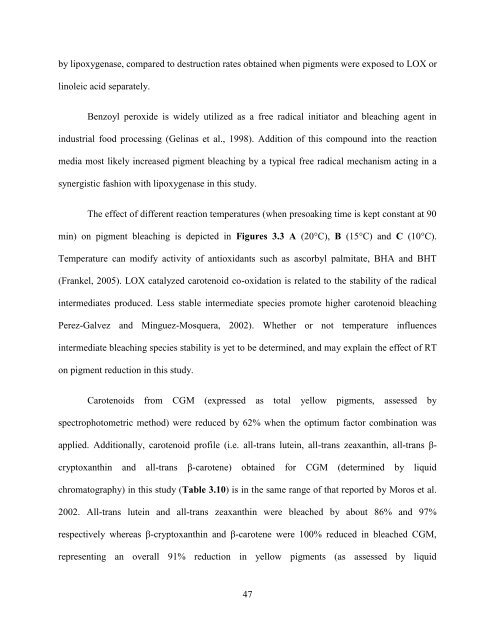Pigment Reduction in Corn Gluten Meal and Its Effects on Muscle ...
Pigment Reduction in Corn Gluten Meal and Its Effects on Muscle ...
Pigment Reduction in Corn Gluten Meal and Its Effects on Muscle ...
Create successful ePaper yourself
Turn your PDF publications into a flip-book with our unique Google optimized e-Paper software.
y lipoxygenase, compared to destructi<strong>on</strong> rates obta<str<strong>on</strong>g>in</str<strong>on</strong>g>ed when pigments were exposed to LOX orl<str<strong>on</strong>g>in</str<strong>on</strong>g>oleic acid separately.Benzoyl peroxide is widely utilized as a free radical <str<strong>on</strong>g>in</str<strong>on</strong>g>itiator <str<strong>on</strong>g>and</str<strong>on</strong>g> bleach<str<strong>on</strong>g>in</str<strong>on</strong>g>g agent <str<strong>on</strong>g>in</str<strong>on</strong>g><str<strong>on</strong>g>in</str<strong>on</strong>g>dustrial food process<str<strong>on</strong>g>in</str<strong>on</strong>g>g (Gel<str<strong>on</strong>g>in</str<strong>on</strong>g>as et al., 1998). Additi<strong>on</strong> of this compound <str<strong>on</strong>g>in</str<strong>on</strong>g>to the reacti<strong>on</strong>media most likely <str<strong>on</strong>g>in</str<strong>on</strong>g>creased pigment bleach<str<strong>on</strong>g>in</str<strong>on</strong>g>g by a typical free radical mechanism act<str<strong>on</strong>g>in</str<strong>on</strong>g>g <str<strong>on</strong>g>in</str<strong>on</strong>g> asynergistic fashi<strong>on</strong> with lipoxygenase <str<strong>on</strong>g>in</str<strong>on</strong>g> this study.The effect of different reacti<strong>on</strong> temperatures (when presoak<str<strong>on</strong>g>in</str<strong>on</strong>g>g time is kept c<strong>on</strong>stant at 90m<str<strong>on</strong>g>in</str<strong>on</strong>g>) <strong>on</strong> pigment bleach<str<strong>on</strong>g>in</str<strong>on</strong>g>g is depicted <str<strong>on</strong>g>in</str<strong>on</strong>g> Figures 3.3 A (20°C), B (15°C) <str<strong>on</strong>g>and</str<strong>on</strong>g> C (10°C).Temperature can modify activity of antioxidants such as ascorbyl palmitate, BHA <str<strong>on</strong>g>and</str<strong>on</strong>g> BHT(Frankel, 2005). LOX catalyzed carotenoid co-oxidati<strong>on</strong> is related to the stability of the radical<str<strong>on</strong>g>in</str<strong>on</strong>g>termediates produced. Less stable <str<strong>on</strong>g>in</str<strong>on</strong>g>termediate species promote higher carotenoid bleach<str<strong>on</strong>g>in</str<strong>on</strong>g>gPerez-Galvez <str<strong>on</strong>g>and</str<strong>on</strong>g> M<str<strong>on</strong>g>in</str<strong>on</strong>g>guez-Mosquera, 2002). Whether or not temperature <str<strong>on</strong>g>in</str<strong>on</strong>g>fluences<str<strong>on</strong>g>in</str<strong>on</strong>g>termediate bleach<str<strong>on</strong>g>in</str<strong>on</strong>g>g species stability is yet to be determ<str<strong>on</strong>g>in</str<strong>on</strong>g>ed, <str<strong>on</strong>g>and</str<strong>on</strong>g> may expla<str<strong>on</strong>g>in</str<strong>on</strong>g> the effect of RT<strong>on</strong> pigment reducti<strong>on</strong> <str<strong>on</strong>g>in</str<strong>on</strong>g> this study.Carotenoids from CGM (expressed as total yellow pigments, assessed byspectrophotometric method) were reduced by 62% when the optimum factor comb<str<strong>on</strong>g>in</str<strong>on</strong>g>ati<strong>on</strong> wasapplied. Additi<strong>on</strong>ally, carotenoid profile (i.e. all-trans lute<str<strong>on</strong>g>in</str<strong>on</strong>g>, all-trans zeaxanth<str<strong>on</strong>g>in</str<strong>on</strong>g>, all-trans β-cryptoxanth<str<strong>on</strong>g>in</str<strong>on</strong>g> <str<strong>on</strong>g>and</str<strong>on</strong>g> all-trans β-carotene) obta<str<strong>on</strong>g>in</str<strong>on</strong>g>ed for CGM (determ<str<strong>on</strong>g>in</str<strong>on</strong>g>ed by liquidchromatography) <str<strong>on</strong>g>in</str<strong>on</strong>g> this study (Table 3.10) is <str<strong>on</strong>g>in</str<strong>on</strong>g> the same range of that reported by Moros et al.2002. All-trans lute<str<strong>on</strong>g>in</str<strong>on</strong>g> <str<strong>on</strong>g>and</str<strong>on</strong>g> all-trans zeaxanth<str<strong>on</strong>g>in</str<strong>on</strong>g> were bleached by about 86% <str<strong>on</strong>g>and</str<strong>on</strong>g> 97%respectively whereas β-cryptoxanth<str<strong>on</strong>g>in</str<strong>on</strong>g> <str<strong>on</strong>g>and</str<strong>on</strong>g> β-carotene were 100% reduced <str<strong>on</strong>g>in</str<strong>on</strong>g> bleached CGM,represent<str<strong>on</strong>g>in</str<strong>on</strong>g>g an overall 91% reducti<strong>on</strong> <str<strong>on</strong>g>in</str<strong>on</strong>g> yellow pigments (as assessed by liquid47
















